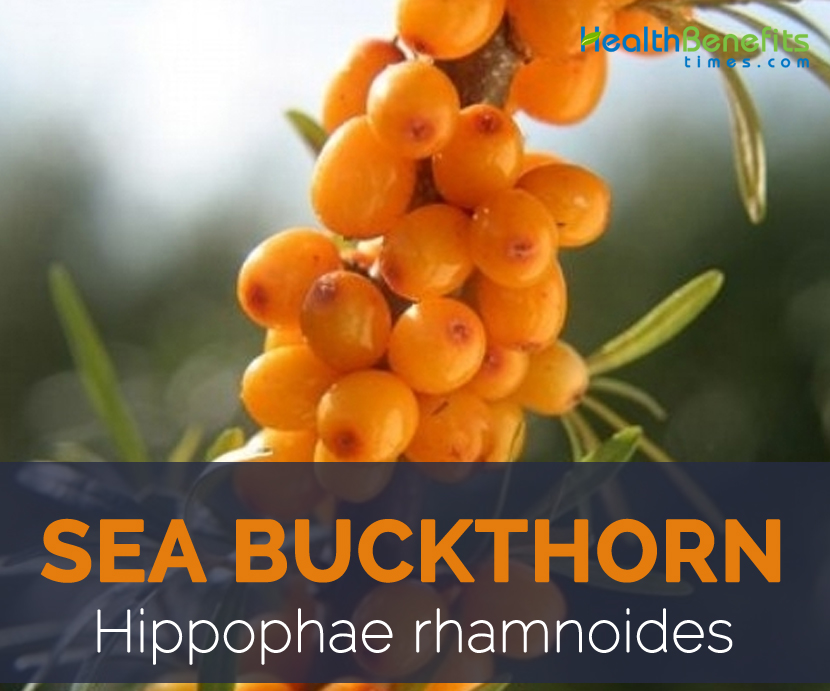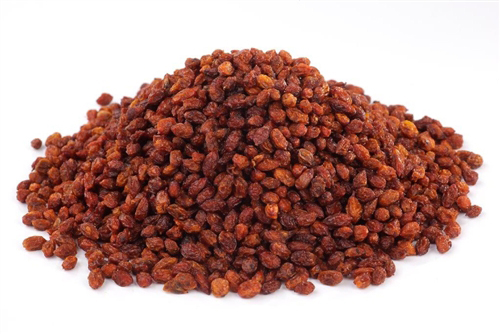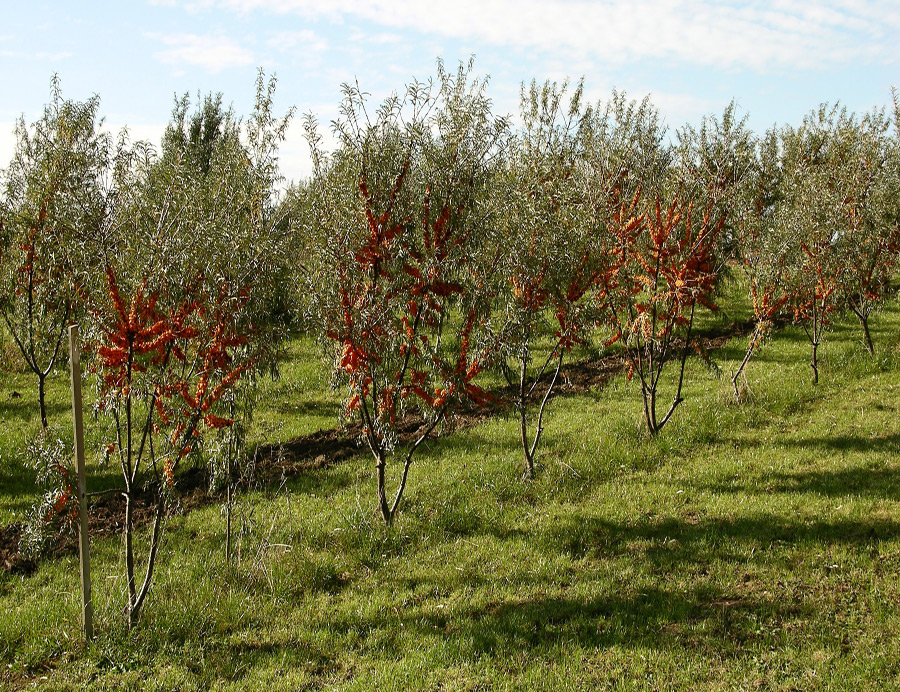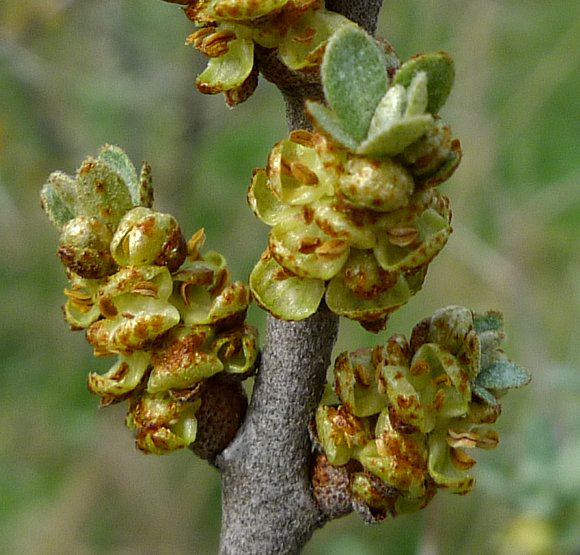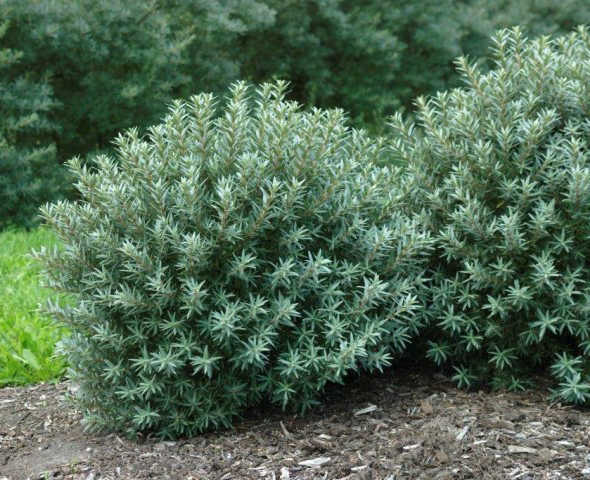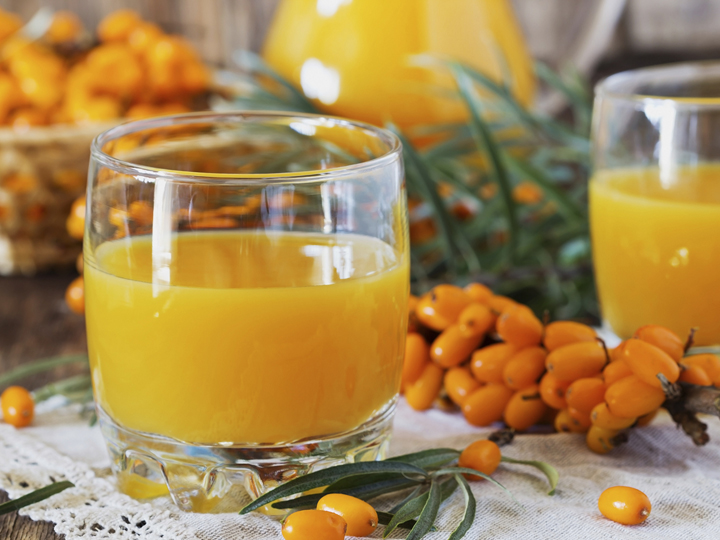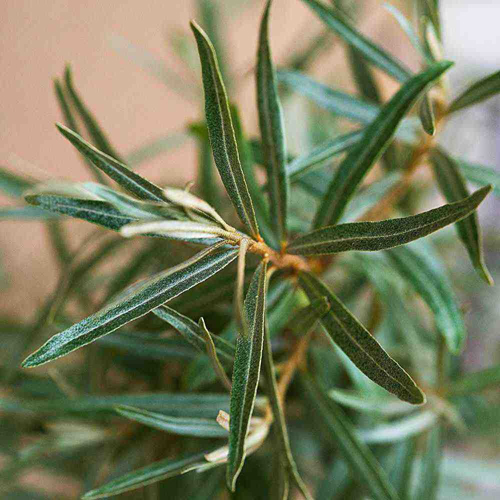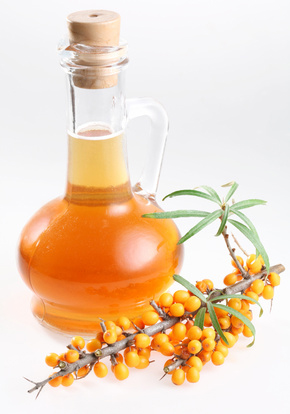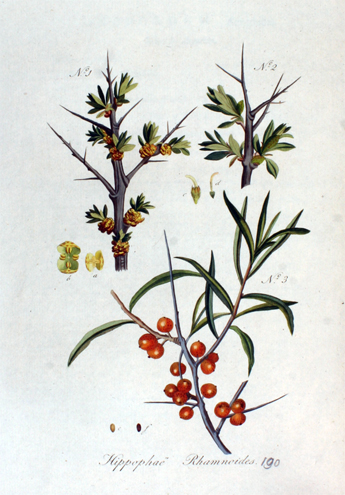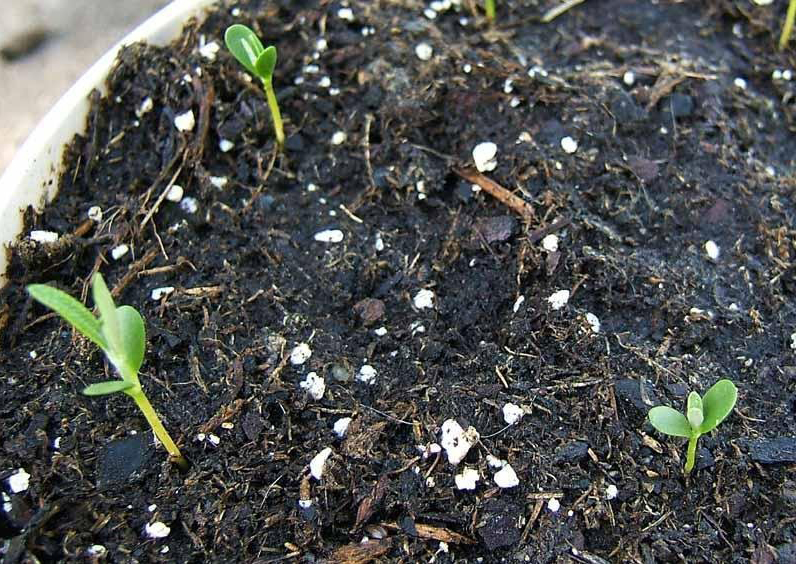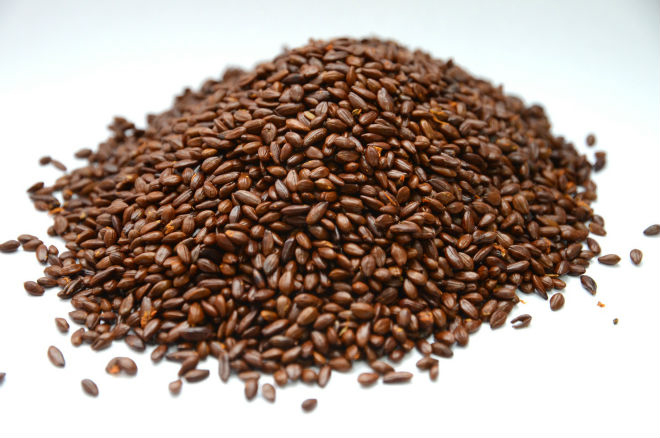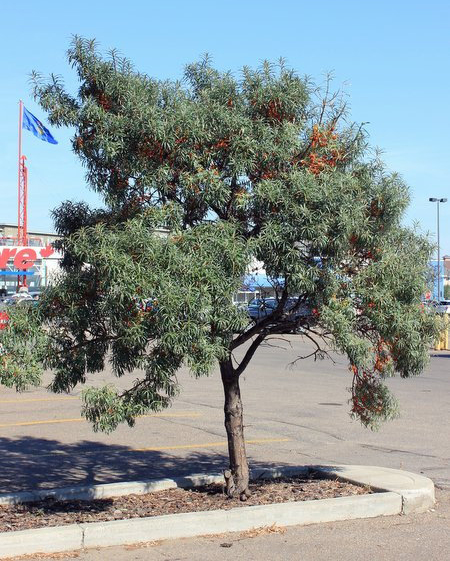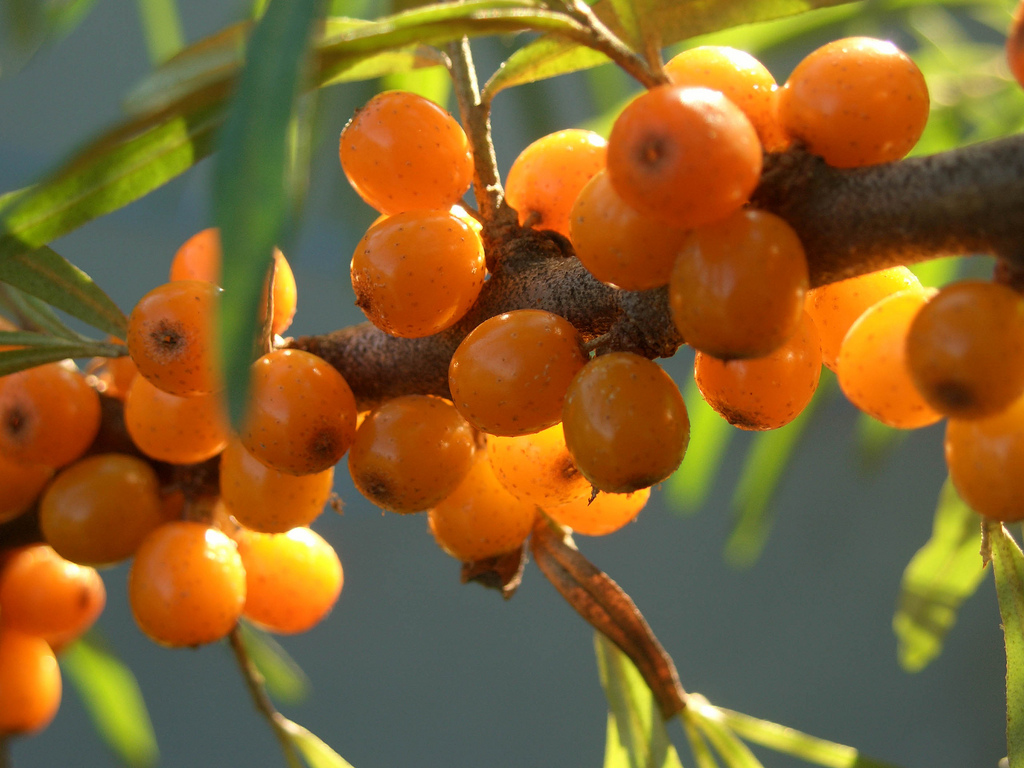Plant
Sea Buckthorn is a medium-sized, hardy, growing deciduous tree-like shrub, 0.5–6 meters (1.6–19.7 ft.) tall, rarely up to 10 meters (33 ft.) in central Asia. It grows along riversides, in mountainous areas, and in sandy and gravel ground and found growing profusely on a wide range of soil types, but does better in soils with a light physical structure, rich in nutrient compounds. Best growth occurs in deep, well drained, sandy loam soil with ample organic matter. It has dense and stiff branches, and is very thorny. Barks are normally brown or black thick and rough and a thick grayish-green crown. Leaves are alternate or opposite, distinct green at the top, and silver-ash green on the underside, lanceolate, 3–8 cm (1.2–3.1 in) long, and less than 7 mm (0.28 in) broad. It is dioecious, with separate male and female plants. Male plants produce flowers, which create the pollen, while female bushes produce the orange berry-like fruit. Flowering normally takes place from April to mid-May.
Fruit
Sea buckthorn is actually a rare species of fruit from Elaeagnaceae family. Sea buckthorn berries are usually pearl-shaped clustered berries 6–9 mm (0.24–0.35 in) in diameter, soft, juicy, and rich in oils and are normally yellowish-orange colored. The fruit consists of one bony, ovoid seed. They are normally oily, bitter, sour, tart and astringent in taste but are high in nutrient value. Due to its astringent, sour and oily taste it is unpleasant to eat raw, unless ‘bletted’ (frosted to decrease the astringency) and/or mixed as a drink with sweeter substances such as apple or grape juice. Apart from its distinctive taste it has higher nutritional value so it is extremely beneficial for all. The peak season for harvesting sea buckthorn is from August to October.
History
The berries and their usage were mentioned in China, 1,200 years ago, and in Tibetan medical texts around 1,000 years ago. From there, Sea Buckthorn spread over Russia and the Ukraine into Europe, finally reaching the British Isles.
Sea buckthorn has a rich history of use in treating numerous medical conditions. It has been called a wonder plant in many Asian countries, including China, India, and Pakistan. The berries have been used for more than 1,000 years in Tibetan and Indian systems of medicine. In traditional Chinese medicine, it has been used to aid digestion and treat cough, circulatory disorders, and pain. Due to its higher nutritional value it is found uses throughout the world.
Health benefits of Sea Buckthorn
Sea Buckthorn is becoming progressively popular for its impressive range of healing properties! Sea-Buckthorn is a thorny shrub that grows near rivers and in sandy soil along the Atlantic coasts of Europe and throughout Asia, where it has been used for centuries in traditional medical applications. The leaves, flowers, fruits and oils from the seeds are all used for remedies. Listed below are some of the popular health benefits of using sea buckthorn
1. Stomach Health
Buckthorn berry juice is one of the best cures if you suffer from upset stomach or gastric distress of any kind. Apart from that buckthorn berry juice can rapidly relieve discomfort and calm inflammation. The anti-inflammatory capacity of this super berry also helps relieve joint pain and sore muscles.(1)
2. Vision Health
Carotenoids are another important antioxidant compound that is found in buckthorn berry, and this important nutrient protects your vision in a major way. Carotenoids help to slow down the progression of macular degeneration, and prevent the development of cataracts along with improving night vision!(2)
3. Brain health
The B vitamins and healthy fats contained in sea buckthorn are outstanding for maintaining brain health, and may assist in preventing or healing conditions such as Alzheimer’s and dementia.
4. Cancer Treatment
Juice from buckthorn berries are extremely valuable for the reduction of cancer, or slowing down its spread. Buckthorn berry consists of high antioxidant content that help to neutralize free radicals, the dangerous byproducts of cellular metabolism. However, in the case of buckthorn berry juice, the anti-cancer abilities cause cell-cycle arrest, so cancer cannot progress; however, it does not encourage apoptosis, like many other antioxidant substances.(3)
5. Aging Process
Buckthorn berry is quite important because of its impact on the aging process. For those people seeking younger-looking skin, or who want to remove age spots and wrinkles, the free radical-neutralizing antioxidants in buckthorn berry are perfect! Drinking buckthorn berry juice, adding the concentrated oil to other foods, or eating the berries themselves are all practical ways to stay young!(4)
6. Diabetes Control
Although research is still on this particular topic, buckthorn berry is good at regulating blood sugar. It means including this delicious fruit to their diet is the wonderful choice for people suffering from diabetes. By eliminating the peaks and drops in blood sugar, super berries like buckthorn can help people live a more normal life!(5)
7. Vitamin C Boost
Apart from boosting immune system, buckthorn helps to improve the health of the skin, the strength of your bones, and flexibility of gums and teeth. Vitamin C contained in buckthorn berry is an essential part in the formation of collagen, which is a vital component of growth and repair throughout the body. Therefore, the high concentration of vitamin C in buckthorn berry makes it an all-around body booster that helps to speed wound healing and recovery from injuries.
8. Circulation
Several research have proven that the high levels of vitamin C in buckthorn berry help to increase the uptake of iron by the body, thus confirming a high, steady blood flow, as iron is a key ingredient in red blood cells.(6)
How to Eat
- Sea buckthorn fruit are used to make pies, jams, lotions, teas, fruit wines, and liquors.
- Sea berry plants also contribute to making an excellent wine and liquor.
- Sea buckthorn is popular as a juice and jam in Finland and other countries.
- Use sea buckthorn leaves to make teas.
Other Traditional Uses and benefits of Sea buckthorn
- Bark and leaves are used for treating diarrhea and dermatological disorders.
- Berry oil, either taken orally or applied topically, is supposed to be a skin softener.
- Sea buckthorn fruit may be added to medications in belief it affects pulmonary, gastrointestinal, cardiac, blood or metabolic disorders in Chinese, Tibetan and Indian medicines.
- It has been used to aid digestion and treat cough, circulatory disorders, and pain in traditional Chinese medicine.
- Oil from the seeds and fruits was used topically to treat chronic dermatoses, frostbite, eczema, psoriasis, cervical erosion lupus erythematosus and burns in Russia.
- Oil from the fruit has been used to treat thrombosis.
- Oil extracts have been used in ophthalmology to treat keratitis, trachoma, conjunctivitis, and injuries or burns of the eyelid.
- Ancient Tibetan medical literature documents the use of sea buckthorn for fever, cough, colds, inflammation, gynecological diseases, toxicity, abscesses, tumors (particularly in the stomach and esophagus), clearing sputum and laxative effect.
- Flowers are used as a skin softener in Tajikistan.
- Extracts from the leaves and branches of the plant are used medicinally to treat colitis and enterocolitis in humans and animals in Mongolia.
- Leaves are used to treat GI and skin disorders, and topically applied to treat rheumatoid arthritis in middle Asia.
- Internal consumption of sea buckthorn berry as tea, juice, or syrup is used for treatment of infections, colds, and flu in the traditional Austrian medicine.
Other Facts
- Sea buckthorn oils are used as a source for ingredients in several commercially available cosmetic products and nutritional supplements.
- Sea buckthorn is a popular garden and landscaping shrub with an aggressive basal shoot system used for barrier hedges and windbreaks, and to stabilize riverbanks and steep slopes.
- Branches may be used by florists for designing ornaments.
- In northwestern China, sea buckthorn shrubs have been planted on the bottoms of dry riverbeds to increase water retention of the soil, thus decreasing sediment loss.
- Sea buckthorn was once distributed free of charge to Canadian prairie farmers by PFRA to be used in shelterbelts.
Storage tips
Sea buckthorn prefers cooler, drier temperatures and should not be left in humid, warm kitchens. Place loosely packed sea buckthorn fruit in the refrigerator, where it will keep for a week. Or, place sea buckthorns in the freezer to extend its lifespan for up to a year.
Side Effects
The pregnant and breast feeding women are not recommended to use the Sea Buckthorn. Sea buckthorn can slow the clotting of blood. The antiplatelet and anticoagulant drugs could interact with the Sea Buckthorn. The use of sea buckthorn with these medications may raise the excess bleeding and bruising. It may interact with clopidogrel, ibuprofen, naproxen, enoxaparin, warfarin, aspirin, diclofenac, dalteparin and heparin. One should consult the doctor before using Buckthorn products along with NSAID drugs or blood thinners.
References:
https://en.wikipedia.org/wiki/Hippophae
http://www.seabuckthorninsider.com/
https://www.drugs.com/npp/sea-buckthorn.html
http://seabuckthorn.com/PRODGDpdf.pdf
https://npgsweb.ars-grin.gov/gringlobal/taxonomydetail.aspx?id=19177
http://www.cabi.org/isc/datasheet/27202
http://davesgarden.com/guides/pf/go/54046/
http://www.thealternativedaily.com/reasons-to-use-sea-buckthorn/
http://kevaind.org/download/seabuckthorn.pdf
http://www.pfaf.org/user/plant.aspx?LatinName=Hippophae+rhamnoides
Comments
| Sea Buckthorn Quick Facts | |
|---|---|
| Name: | Sea Buckthorn |
| Scientific Name: | Hippophae rhamnoides |
| Origin | Native over a wide area of Europe and Asia. |
| Colors | Yellowish-orange |
| Shapes | Pearl-shaped clustered berries 6–9 mm (0.24–0.35 in) in diameter, soft, juicy, and rich in oils. |
| Taste | Oily, bitter, sour, tart and astringent |
| Health benefits | Stomach Health, Vision Health, Brain health, Cancer Treatment, Aging Process, Diabetes Control, Vitamin C Boost, Circulation |
| More facts about Sea Buckthorn | |
| Scientific name | Hippophae rhamnoides |
|---|---|
| Kingdom | Plantae |
| Subkingdom | Tracheobionta |
| Order | Rhamnales |
| Family | Elaeagnaceae |
| Genus | Hippophae L. |
| Species | Hippophae rhamnoides L. |
| Super division | Spermatophyta |
| Division | Magnoliophyta |
| Class | Magnoliopsida |
| Sub Class | Rosidae |


